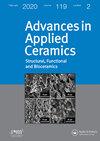浆料反向挤压法是制备β -氧化铝钠电解质封端管的合适方法
IF 1.6
4区 材料科学
Q3 MATERIALS SCIENCE, CERAMICS
引用次数: 1
摘要
本研究采用浆料反向挤压法制备了β -氧化铝钠电解质封端管(壁厚为1mm,外径为8.0 mm)。为此,设计了两片式挤出模具,以-氧化铝钠粉、聚乙烯醇吡咯烷酮为粘结剂,乙二醇为增塑剂,制备了可挤出的水基糊状物。考察了溶剂含量对膏体流变参数的影响,以及柱塞挤压速度对液相分离的影响。结果表明,制备可挤出糊状物的最佳溶剂含量为30 ~ 35 wt-%,当滑块速度小于1.2 mm s - 1时,会发生明显的液相分离。结果表明,采用反向挤压工艺,在适当的条件下,可以成功制备出高密度(约97%)、表面质量良好的封端管。本文章由计算机程序翻译,如有差异,请以英文原文为准。
Paste backward extrusion process as a suitable method for fabrication of sodium beta-alumina electrolyte closed-end tubes
ABSTRACT In this study, paste backward extrusion is introduced for fabrication of sodium beta-alumina electrolyte closed-end tubes (with a wall thickness of 1 mm and external diameter of 8.0 mm). For this purpose, the two-piece extrusion die was designed and extrudable water-based paste was prepared by using sodium beta-alumina powder, polyvinyl pyrrolidone, as a binder, and ethylene glycol as a plasticizer. The effect of solvent content on the rheological parameters of the paste and the ram extrusion velocity on the liquid phase separation are investigated. The results indicate that the optimum solvent content for making the extrudable paste is in the range of 30–35 wt-%, and the liquid phase separation is obviously occurred when the ram velocity is lower than 1.2 mm s−1. It was also shown that by using backward extrusion, and by applying optimum conditions, closed-end tubes with high density (about 97%) and good surface quality could be fabricated successfully.
求助全文
通过发布文献求助,成功后即可免费获取论文全文。
去求助
来源期刊

Advances in Applied Ceramics
工程技术-材料科学:硅酸盐
CiteScore
4.40
自引率
4.50%
发文量
17
审稿时长
5.2 months
期刊介绍:
Advances in Applied Ceramics: Structural, Functional and Bioceramics provides international coverage of high-quality research on functional ceramics, engineering ceramics and bioceramics.
 求助内容:
求助内容: 应助结果提醒方式:
应助结果提醒方式:


